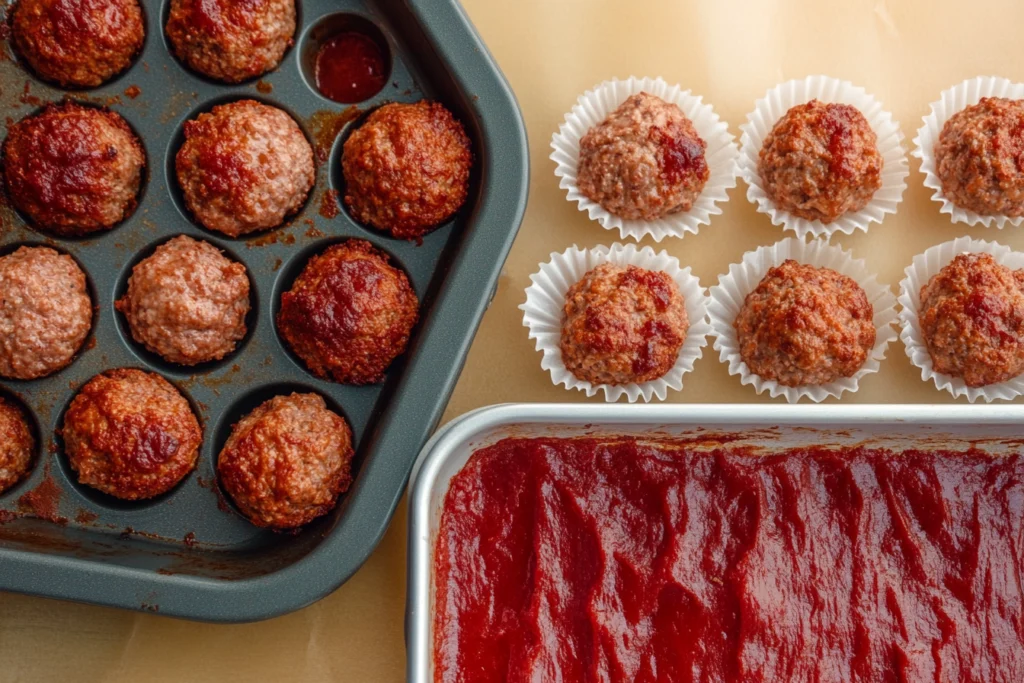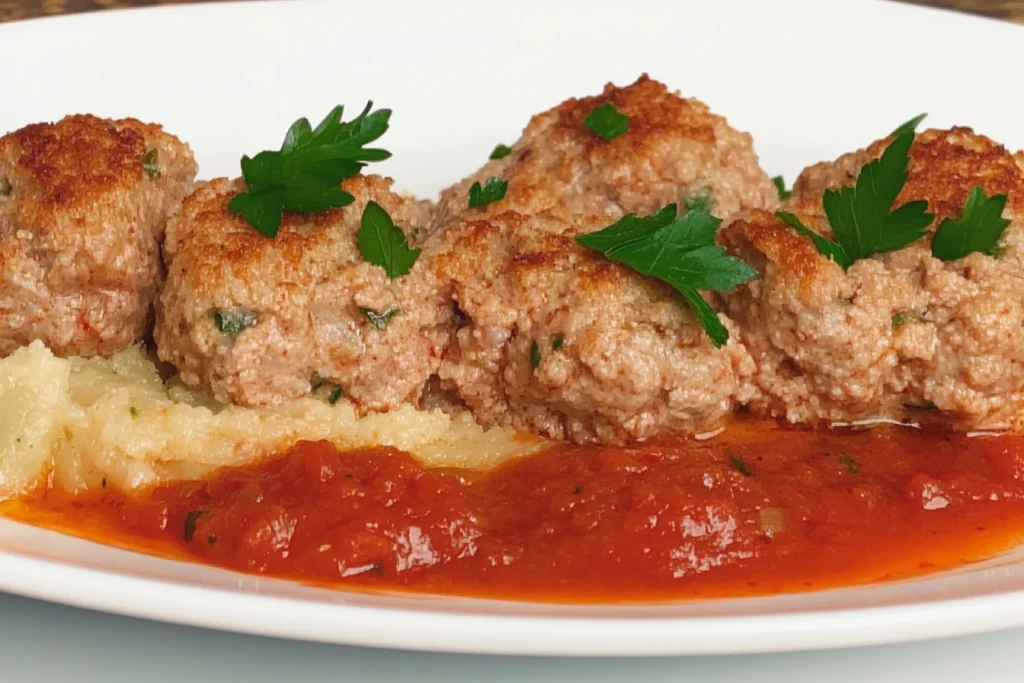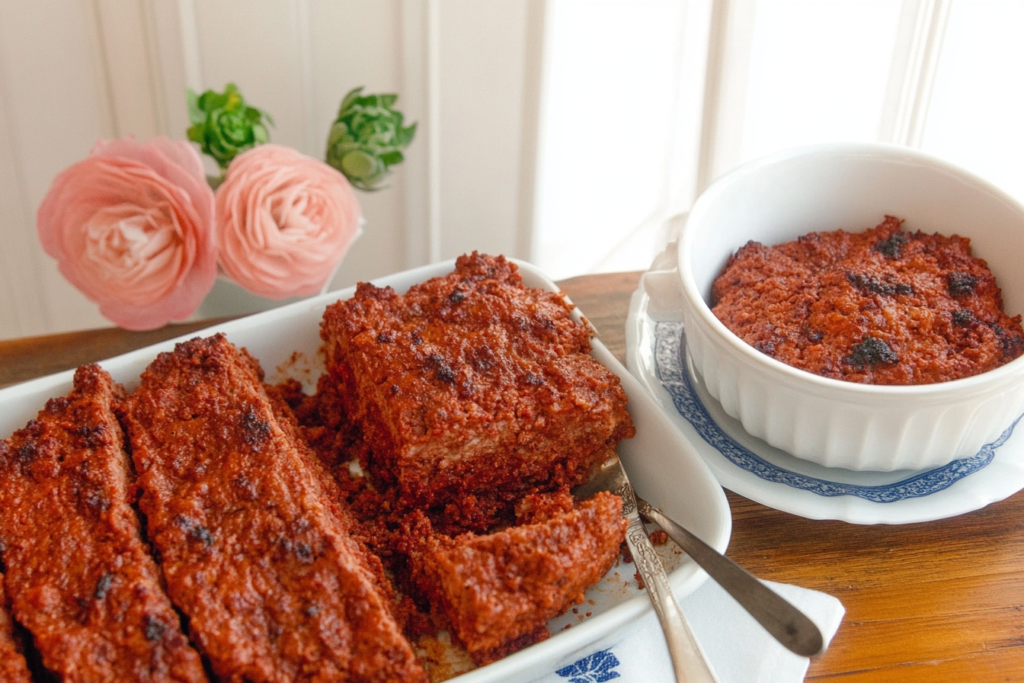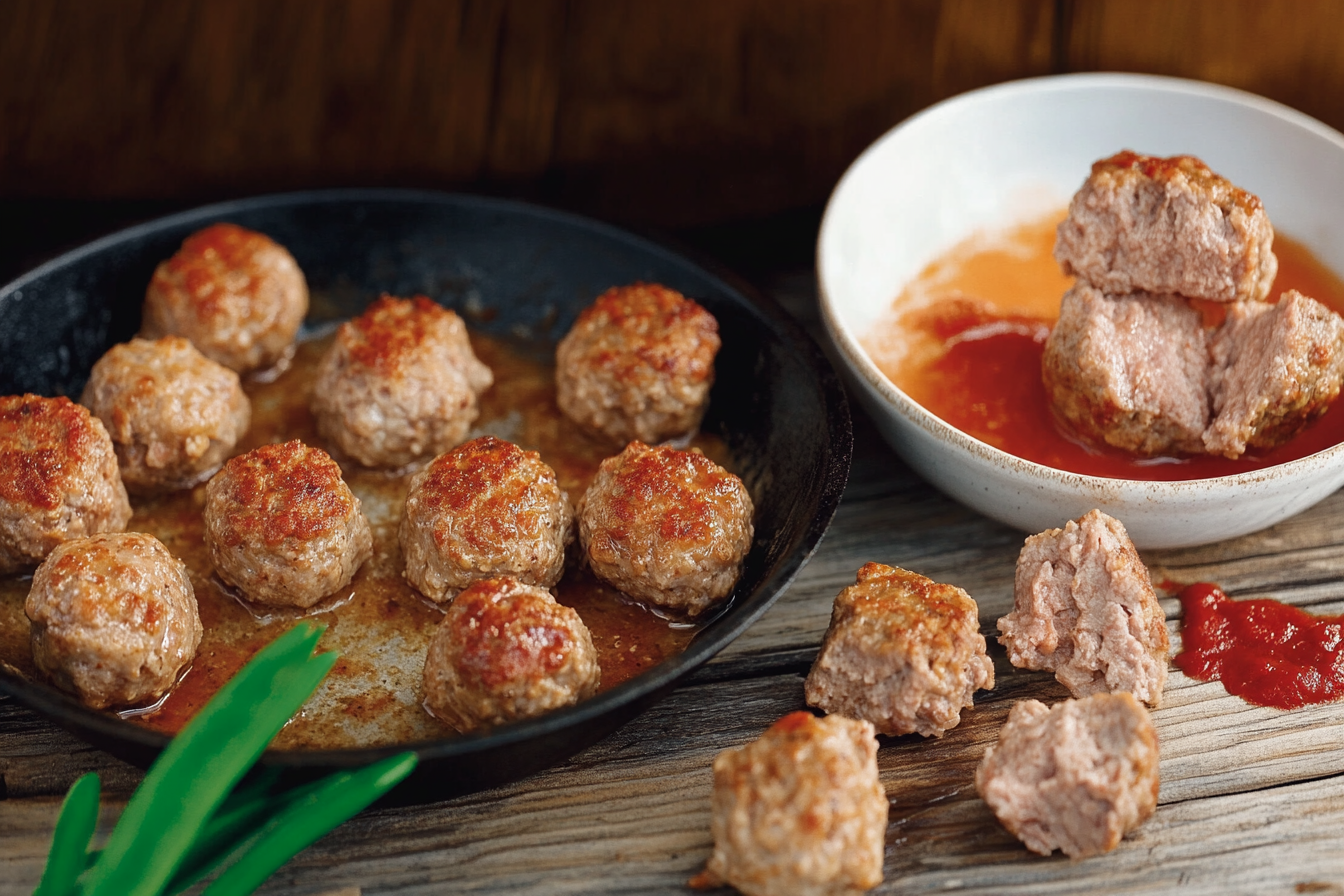Part 1: Introduction and Overview
WhWhat Are Meatballs and Meatloaf?
Cooks around the world have celebrated meatballs and meatloaf as classic, versatile dishes built on the foundation of ground meat. While these dishes share some similarities, their distinct forms, preparation techniques, and cultural contexts set them apart.
- Meatballs: These small, spherical servings of ground meat combine binders and seasonings to create flavorful bites. Cooks typically prepare them as individual portions, making meatballs a flexible choice for a wide variety of meals.
- Meatloaf: This loaf-shaped dish blends ground meat with additional ingredients, forms it into a loaf, and bakes it whole. After cooking, meatloaf is sliced and served, often as part of a hearty family meal.
Both dishes thrive in a range of cuisines, thanks to their adaptability and simplicity.
Origins and History of Meatballs
The history of meatballs stretches back thousands of years. Persian cooks likely developed the first iterations of the dish, seasoning minced meat and forming it into balls before frying or simmering them. Known as kofta, these early meatballs spread along trade routes and influenced global cuisines.
Key developments in meatball history include:
- Italy: During the Renaissance, cooks created polpette by blending meat with breadcrumbs, cheese, and herbs. Each region adapted the recipe to suit local tastes.
- Sweden: In the 18th century, Swedish chefs introduced köttbullar. They added cream and spices like allspice to create the distinctive flavor.
- Asia: Chinese and Vietnamese cuisines brought seafood into the mix with fish-based meatballs, while dishes like lion’s head featured large pork meatballs with a savory profile.
The meatball’s adaptability, affordability, and ability to suit different tastes have cemented its popularity across the globe.

Origins and History of Meatloaf
Compared to the ancient origins of meatballs, meatloaf emerged relatively recently. European cooks in the medieval era blended scraps of meat with grains, nuts, and dried fruits to create dishes resembling pâté. Over time, the concept evolved into recognizable forms of meatloaf.
Significant milestones in meatloaf history include:
- Germany: German chefs created Hackbraten, a dish similar to modern meatloaf. They often included boiled eggs within the loaf for added texture and presentation.
- United States: During the Great Depression, American home cooks embraced meatloaf as an economical way to stretch limited meat supplies. The dish became a household staple.
- France: French cuisine refined the concept into pâté en croûte, an elaborate version of meatloaf encased in pastry.
Today, meatloaf represents the epitome of comfort food, particularly in the United States, where it frequently appears at family dinners.
A Comparative Definition of Meatballs and Meatloaf
Although meatballs and meatloaf share the same foundational ingredients, their differences are evident in their preparation, serving style, and purpose.
- Meatballs: Small, round portions typically served as individual pieces or added to soups, pasta, or sauces.
- Meatloaf: Shaped into a loaf and cooked as a single unit, then sliced and served as part of a larger meal.
The way these dishes are prepared and consumed highlights their adaptability to different cultural and culinary contexts.
How Cultural Influences Shape These Dishes
Both meatballs and meatloaf reflect the diversity of the cultures that embrace them.
- Meatballs:
- Italian cuisine pairs them with marinara sauce and pasta.
- Swedish cuisine emphasizes creamy sauces and lingonberry jam.
- In Asian cuisines, they often appear in soups or curries, showcasing flavors like ginger, soy, or coconut milk.
- Meatloaf:
- In America, it’s typically glazed with ketchup or barbecue sauce and served with mashed potatoes.
- German versions incorporate hard-boiled eggs for a unique twist.
- Modern variations cater to vegetarian or plant-based diets.
Cultural adaptations keep these dishes relevant and exciting in the modern culinary landscape.
Key Ingredients in Meatballs: A Global Perspective
The ingredients in meatballs vary widely depending on the region, but the core components remain consistent:
- Proteins:
- Beef, pork, lamb, chicken, or turkey.
- Seafood-based options, like fish balls, in Asian and Mediterranean cuisines.
- Binders:
- Eggs and breadcrumbs for structure.
- Potatoes or rice in Scandinavian and Middle Eastern recipes.
- Seasonings:
- Herbs like parsley, cilantro, or dill.
- Spices such as nutmeg, cinnamon, or cumin.
The use of local ingredients ensures that meatballs resonate with the tastes and traditions of the region they’re served in.
Key Ingredients in Meatloaf: Traditional and Modern Variations
Meatloaf recipes follow a similar principle but focus on creating a cohesive loaf that holds its shape.
- Base Protein:
- Beef, pork, or a combination of meats for depth of flavor.
- Turkey or plant-based proteins for lighter or vegetarian options.
- Fillers and Binders:
- Oats, breadcrumbs, or crushed crackers.
- Eggs to bind the mixture and enhance moisture.
- Seasonings and Enhancers:
- Worcestershire sauce, mustard, or ketchup for savory undertones.
- Fresh herbs, garlic, or onions for flavor.
Modern versions often experiment with ingredients like lentils, quinoa, or even vegan meat substitutes.
Why Do Meatballs and Meatloaf Often Get Confused?
The confusion between meatballs and meatloaf stems from their shared ingredients and overlapping flavor profiles. Both dishes:
- Use ground meat as their base.
- Rely on binders like breadcrumbs and eggs.
- Incorporate similar seasonings, such as garlic, onion, and herbs.
However, their preparation and serving methods set them apart. Meatballs are individually portioned and versatile, while meatloaf is a singular, loaf-shaped dish intended for slicing.
The Role of Ground Meat in Both Recipes
Ground meat is the cornerstone of both dishes, offering a versatile and affordable protein source.
- Meatballs: Finely ground meat creates a uniform texture, essential for shaping and cooking evenly.
- Meatloaf: Coarser grinds add structure and moisture, preventing the loaf from becoming too dense.
The choice of ground meat—whether beef, pork, or turkey—affects the flavor and richness of the final dish.
The Evolution of Meatball and Meatloaf Recipes Over Time
The recipes for meatballs and meatloaf have evolved significantly to reflect changing tastes and dietary needs:
- Historical Recipes:
- Meatballs were simple and often relied on spices to mask the taste of preserved meats.
- Early meatloaf recipes were rustic, incorporating grains and nuts for sustenance.
- Modern Innovations:
- Gourmet meatballs now feature high-end ingredients like truffle oil or artisanal cheeses.
- Meatloaf has transformed into a healthier dish with lean meats, vegetables, and alternative grains.
The adaptability of these dishes ensures their enduring popularity in kitchens worldwide.
This detailed comparison of meatballs and meatloaf provides a foundation for understanding their similarities and differences. From their historical roots to their modern-day variations, these dishes showcase the creativity and diversity of culinary traditions across the globe.
Part 2: Preparation, Cooking Techniques, and Serving Styles
How Are Meatballs Made?
Making meatballs involves a blend of ingredients to achieve the right balance of flavor, texture, and moisture. The process allows cooks to customize the recipe based on personal preferences or regional styles.
Steps to prepare meatballs:
- Choose your ground meat: Popular choices include beef, pork, chicken, lamb, or a combination. Each meat contributes a unique flavor and fat content.
- Incorporate binders: Breadcrumbs and eggs help hold the meat mixture together. Alternative binders like mashed potatoes or cooked rice work for specific diets.
- Season generously: Use garlic, onion, parsley, or spices such as paprika, nutmeg, or cumin, depending on the flavor profile you want.
- Shape the meatballs: Roll small portions of the mixture into uniform spheres using your hands or a scoop.
- Cook the meatballs: Select a cooking method that matches the desired outcome, such as frying for a crispy exterior or simmering in sauce for added tenderness.
The simplicity of the process allows for endless variations, making meatballs a favorite in cuisines worldwide.
Step-by-Step Guide to Preparing Meatballs
Here’s a step-by-step method to ensure perfect meatballs every time:
- Prepare the ingredients: Mince garlic and onions, chop fresh herbs, and measure out breadcrumbs and eggs.
- Mix the meat and binders: In a large bowl, combine the ground meat with breadcrumbs, eggs, onions, and seasonings. Mix lightly to avoid overworking the meat.
- Shape the balls: Scoop even portions of the mixture and roll them between your palms. Aim for uniformity to ensure consistent cooking.
- Cook using your preferred method:
- Fry the meatballs in oil for a crispy exterior.
- Bake them on a sheet pan for a healthier alternative.
- Simmer in sauce for a soft, infused flavor.
Pro Tip: Chilling meatballs for 20–30 minutes before cooking helps them maintain their shape during the process.
Meatloaf: Classic Preparation Techniques
The preparation of meatloaf involves layering flavors and ensuring the loaf holds its shape while retaining moisture.
Steps to prepare meatloaf:
- Combine the base ingredients: Mix ground meat with binders (e.g., breadcrumbs or oats) and flavor enhancers like onions, garlic, or Worcestershire sauce.
- Shape the loaf: Press the mixture into a loaf pan or shape it by hand on a baking sheet.
- Add a glaze: Spread ketchup, barbecue sauce, or a brown sugar-mustard blend over the top to create a flavorful crust.
- Bake the meatloaf: Cook in a preheated oven at 350°F (175°C) until the internal temperature reaches 160°F (71°C).
Serving tip: Let the meatloaf rest for 10 minutes before slicing to ensure clean cuts and retain its juices.
Cooking Methods for Meatballs (Frying, Baking, Braising, etc.)
The versatility of meatballs extends to the ways they can be cooked, each method offering unique results:
- Frying: Creates a golden, crispy exterior while keeping the inside tender. Ideal for standalone meatballs or appetizers.
- Baking: A healthier, hands-off method that ensures even cooking. Line the baking sheet with parchment to prevent sticking.
- Braising: Simmering meatballs in sauces such as marinara or coconut curry adds flavor and moisture. This method is popular in Italian and Asian cuisines.
- Grilling: Imparts a smoky flavor and works well for outdoor gatherings or kabob-style servings.
Each method suits different meal presentations and enhances the dish’s overall texture and flavor.

Cooking Techniques for Meatloaf (Baking, Smoking, etc.)
Meatloaf traditionally relies on baking but can also benefit from modern or alternative cooking techniques:
- Baking: Ensures even cooking and allows a glaze to form a flavorful crust.
- Smoking: Adds depth and complexity with a smoky aroma, ideal for outdoor cooking enthusiasts.
- Slow Cooking: Produces a moist and tender loaf, especially when cooked with a sauce or broth.
- Air Frying: A newer method that delivers a crispy outer layer with reduced cooking time.
Experimenting with cooking methods can elevate a traditional meatloaf into a unique culinary experience.
Textural Differences Between Meatballs and Meatloaf
Texture plays a significant role in distinguishing these two dishes:
- Meatballs: Small size and individual cooking allow for varied textures. Fried meatballs have a crispy exterior, while braised versions are softer and absorb sauces.
- Meatloaf: Maintains a denser texture, with a uniform consistency throughout. The outer crust adds a contrasting layer when glazed or baked.
Factors such as fat content, binders, and cooking methods influence the final texture, making both dishes enjoyable in their unique ways.
Flavor Profiles: How Spices and Seasonings Differ
The spices and seasonings used in meatballs and meatloaf cater to different culinary traditions:
- Meatballs:
- Italian meatballs feature garlic, oregano, and parsley.
- Swedish köttbullar include warm spices like nutmeg and allspice.
- Asian versions may use ginger, soy sauce, or five-spice powder.
- Meatloaf:
- Traditional American meatloaf incorporates garlic, onion, Worcestershire sauce, and ketchup.
- German Hackbraten may feature mustard or caraway seeds.
The spices used in these dishes highlight their cultural roots while allowing endless customization.
Common Sauces and Sides Served with Meatballs
Sauces and sides elevate meatballs into a complete meal. Popular options include:
- Sauces:
- Marinara for Italian-style meatballs.
- Cream gravy for Swedish meatballs.
- Spicy tomato-based sauces in Indian or Middle Eastern cuisines.
- Sides:
- Pasta, like spaghetti or egg noodles.
- Mashed potatoes or steamed rice.
- Crusty bread for dipping into sauce.
The choice of accompaniments often reflects the regional origins of the recipe.
Popular Accompaniments for Meatloaf
Meatloaf pairs well with hearty sides that complement its rich flavors:
- Potatoes: Mashed, roasted, or baked varieties create a comforting combination.
- Vegetables: Roasted carrots, green beans, or peas balance the dish.
- Gravy or Sauce: Mushroom or onion gravy enhances flavor and moisture.
- Bread: Dinner rolls or cornbread provide a satisfying addition to the plate.
These accompaniments make meatloaf a quintessential family-style comfort food.
Single-Serve (Meatballs) vs. Family-Style (Meatloaf): Presentation Differences
The presentation of meatballs and meatloaf reflects their roles in different dining settings:
- Meatballs:
- Ideal for single servings or as part of appetizers.
- Easy to serve at casual gatherings or in soups and pasta dishes.
- Meatloaf:
- Best suited for family-style meals.
- Presented in slices alongside sides, making it a centerpiece of the table.
These presentation styles highlight the unique purposes of each dish, catering to different occasions and preferences.
Part 3: Nutritional, Cultural, and Culinary Perspectives
Nutritional Comparison: Meatballs vs. Meatloaf
When comparing meatballs and meatloaf, their nutritional profiles depend on the ingredients and preparation methods. Both dishes can be part of a balanced diet, but the calorie, protein, and fat content vary.
- Meatballs:
- Portion size: A single serving of meatballs is typically smaller, with individual pieces being bite-sized.
- Cooking methods, like frying, can increase calorie content due to added oils, while baking or simmering in sauce reduces fat.
- Additional ingredients like cheese or cream (e.g., in Swedish meatballs) can contribute to higher calorie counts.
- Meatloaf:
- Often larger portions, as slices are thicker and more substantial.
- Binders such as breadcrumbs, oats, or rice add carbohydrates.
- Glazes like ketchup or barbecue sauce contribute sugar and calories.
Both dishes can be modified for dietary needs, such as using lean meats, reducing fillers, or opting for plant-based variations.
Portion Sizes and Caloric Differences
Meatballs are inherently portion-controlled, allowing for more precise calorie management. For instance:
- A single beef meatball (about 1 ounce) contains roughly 60–80 calories, depending on fat content.
- A plate of spaghetti with meatballs may contain 600–800 calories, accounting for pasta and sauce.
In contrast, meatloaf servings tend to be larger:
- One slice of traditional meatloaf (about 5–6 ounces) provides 250–350 calories.
- Additional sides like mashed potatoes or gravy significantly increase the caloric load.
Customizing portion sizes and ingredients allows you to tailor each dish to meet specific dietary goals.
Protein, Fat, and Carb Content in Both Dishes
Both meatballs and meatloaf provide a balance of macronutrients:
- Protein:
- Both dishes are rich in protein due to their meat base. Using leaner cuts or mixing with plant proteins can reduce fat content without sacrificing protein levels.
- Fat:
- Meatloaf often contains slightly more fat due to larger portions and ingredients like eggs and glazes.
- Meatballs, especially fried ones, may have added fat from cooking oils.
- Carbohydrates:
- Fillers such as breadcrumbs or oats contribute carbs, with meatloaf often containing a higher proportion of these ingredients.
- Sauces (e.g., marinara or barbecue) also add sugar-derived carbs.
Meatballs in Global Cuisines: Italian, Swedish, Asian Variations
Meatballs enjoy global recognition, with each culture adding its unique twist:
- Italian: Italian meatballs often feature a mix of beef and pork, seasoned with garlic, parsley, and parmesan. They are traditionally served in marinara sauce over pasta.
- Swedish: Swedish köttbullar include cream, breadcrumbs, and warm spices like nutmeg. They are served with creamy gravy and lingonberry jam.
- Asian:
- Chinese meatballs, such as lion’s head, are larger and braised in a soy-based sauce.
- Vietnamese meatballs (used in pho or bánh mì) are smaller and often incorporate fish sauce and herbs.
Each variation highlights local ingredients and cooking techniques, reflecting the dish’s adaptability.

Meatloaf Around the World: American, German, and Other Styles
While meatloaf is often associated with American comfort food, other cultures have embraced similar recipes:
- American: Traditional meatloaf features a beef base mixed with breadcrumbs and eggs, topped with a ketchup glaze. Variations include turkey meatloaf or versions with added vegetables.
- German: German Hackbraten often includes boiled eggs in the center and is served with mustard-based sauces.
- Other Styles:
- French pâté en croûte is a sophisticated version encased in pastry.
- Filipino embutido incorporates ground pork, raisins, and boiled eggs, wrapped in foil and steamed.
These variations showcase meatloaf’s ability to adapt to different cultural preferences.
The Role of Meatballs in Quick and Casual Meals
Meatballs are a go-to option for quick, versatile meals:
- They cook quickly, especially when fried or baked.
- Their small size makes them perfect for soups, stews, or as an appetizer.
- Pairing with pasta, rice, or bread creates a filling meal in minutes.
Additionally, meatballs freeze well, making them a convenient choice for meal prep.
Meatloaf as a Comfort Food and Its Place in Formal Meals
Unlike the quick and casual appeal of meatballs, meatloaf is synonymous with hearty, sit-down meals:
- Its loaf shape and large size make it ideal for family-style dining.
- The dish’s association with nostalgia and home cooking enhances its role as comfort food.
- Gourmet versions of meatloaf can feature high-quality ingredients, making it suitable for formal occasions.
Both its simplicity and versatility contribute to meatloaf’s enduring popularity.
Vegetarian and Vegan Variations of Meatballs and Meatloaf
With plant-based diets on the rise, chefs have developed creative vegetarian and vegan versions of both dishes:
- Vegetarian Meatballs:
- Ingredients include lentils, chickpeas, mushrooms, or tofu.
- Flavorings like soy sauce, nutritional yeast, and herbs enhance the taste.
- Vegetarian Meatloaf:
- Common bases include lentils, beans, or textured vegetable protein.
- Egg substitutes like flaxseed or aquafaba act as binders.
These variations cater to diverse dietary needs while preserving the essence of the original dishes.
Storage, Reheating, and Leftover Tips
Proper storage ensures the longevity of meatballs and meatloaf:
- Refrigeration:
- Store cooked meatballs or meatloaf in an airtight container for up to 3–4 days.
- Freezing:
- Freeze meatballs (cooked or uncooked) on a tray before transferring to a freezer bag. Meatloaf can be frozen whole or in slices for convenience.
- Reheating:
- Reheat meatballs in sauce on the stovetop to restore moisture.
- Warm meatloaf slices in the oven, covered with foil, to prevent drying out.
Repurposing leftovers is easy—use meatballs in subs or stir-fries and meatloaf in sandwiches.
Choosing Between Meatballs and Meatloaf: Practical Considerations
The decision to prepare meatballs or meatloaf often depends on the occasion, cooking time, and personal preferences:
- Choose meatballs for:
- Quick meals, appetizers, or versatile dishes.
- Individual portions that suit casual settings.
- Choose meatloaf for:
- Family-style dinners or meal prepping.
- A heartier, sliceable main course.
Both dishes cater to different needs, making them equally valuable in the kitchen.

